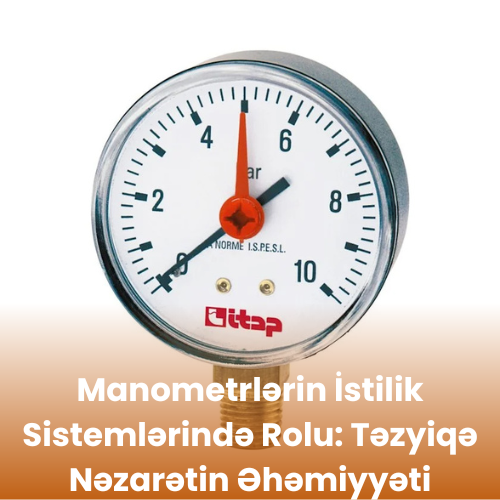The Role of Pressure Gauges in Heating Systems: The Importance of Pressure Control

What Is a Manometer?
A manometer is a device used to measure the pressure of gases or liquids. It is widely utilized in heating, water, gas, pneumatic, and hydraulic systems. Manometers play a crucial role in ensuring both safety and the proper functioning of systems by indicating pressure levels.
How Does a Manometer Work?
Traditional (mechanical) manometers typically operate based on the Bourdon tube principle. This involves a curved metal tube that tends to straighten when internal pressure increases. As the pressure changes, the tube's shape alters, and this movement is transmitted to the gauge's pointer, displaying the pressure in units such as bar, kPa, or psi.
Types of Manometers
-
Mechanical Manometers – Common and cost-effective.
-
Digital (Electronic) Manometers – Provide more accurate readings and display data via a screen.
-
Differential Manometers – Measure the pressure difference between two points.
-
Vacuum Manometers – Designed to measure pressures below atmospheric levels.
Role of Manometers in Heating Systems
In heating systems, the primary function of a manometer is to monitor system pressure. If the pressure is too low, water circulation weakens, leading to inefficient heating. Conversely, excessive pressure can be hazardous, potentially damaging pipes and radiators or even causing explosions.
Importance of Pressure in Heating Systems
Heating systems are complex engineering setups that ensure comfortable and energy-efficient heating in homes, offices, and industrial facilities during winter months. Maintaining stable and appropriate pressure levels is vital for the system's effective and safe operation. Pressure is considered the "heart" of the heating system; any issues can disrupt functionality and cause significant damage.
What Is Pressure and Why Is It Important?
In a heating system, pressure refers to the force that enables water (or another heat carrier) to move through pipes. Normal pressure values vary depending on the system's type and configuration but typically range between 1 and 2.5 bar. These values are considered optimal for safe and efficient operation.
Consequences of Low Pressure
-
Radiators may not receive water, resulting in inadequate heating.
-
Boilers or circulation pumps may malfunction.
-
Air bubbles can form within the system.
-
Overall system performance declines.
Consequences of High Pressure
-
Increased risk of damage to pipes, radiators, and other components.
-
Activation of safety valves, leading to water leakage.
-
Overloading of the boiler, potentially causing failure.
How to Monitor Pressure?
Manometers are used to monitor pressure in heating systems. Additionally, automatic safety valves and expansion tanks help balance pressure. Regularly checking and adjusting the system's pressure is essential.
Factors to Consider When Selecting a Manometer
Manometers are vital for monitoring pressure in heating, water, gas, and other technical systems, ensuring safety and proper operation. To achieve accurate results and select a suitable manometer for your system, consider the following factors:
-
Pressure Range
The manometer's measurement range should align with the system's pressure.
-
Optimal Choice: The operating pressure should be less than two-thirds of the device's maximum reading.
For instance, if the system operates at 2 bar, a manometer with a 4–6 bar range is recommended.
-
-
Type of Manometer
Different types are available based on application:
-
Mechanical Manometers – Simple and affordable, commonly used in household systems.
-
Digital Manometers – Offer precise measurements, suitable for industrial and technical applications.
-
Differential Manometers – Measure pressure differences between two points.
-
Vacuum or Combined (Vacuum + Pressure) Manometers – Display both positive and negative pressures.
-
-
Installation Type
The installation method should suit the system's design:
-
Front Mounting
-
Rear Mounting
-
Flanged or Panel Mounting
This facilitates easy placement on panels, pipes, or other surfaces.
-
-
Material Quality
Depending on the operating environment (temperature, pressure, chemicals, etc.), the manometer's body and internal components should be made of durable materials like stainless steel or brass. High-quality materials are essential for harsh and aggressive conditions.
-
Accuracy
For applications requiring high precision, industrial and laboratory-grade manometers with ±1% or ±0.5% accuracy should be chosen. For household systems, ±2.5% accuracy is typically sufficient.
-
Certification and Compliance
Ensure the manometer meets international or local standards (e.g., ISO, CE) to guarantee quality and reliability.
-
Additional Features
Some manometers offer extra functionalities:
-
Backlit display (in digital models)
-
Maximum pressure indicator
-
Automatic alerts and warning systems
-
Frequently Asked Questions About Manometers
What Is the Purpose of a Manometer?
A manometer measures the pressure within a system (e.g., heating, water, or gas), which is crucial for safe and efficient operation.
What Units Do Manometers Use to Measure Pressure?
Common units include:
-
Bar
-
Pascal (Pa, kPa)
-
Psi (pounds per square inch)
The choice depends on system requirements and regional standards.
What Pressure Range Do Manometers Operate Within?
This varies by model and application. For example, household heating systems typically use manometers ranging from 0 to 4 bar. Selection should be based on the system's maximum pressure.
What Should I Do If the Manometer Readings Are Incorrect?
If readings don't match actual pressure:
-
The manometer may be faulty.
-
Calibration might be necessary.
-
There could be installation or connection issues.
In such cases, consult a technician to inspect the device.
What If the Manometer Breaks or Leaks Water/Oil?
Immediately shut down the system, address the leak, and replace the manometer to prevent hazardous situations.
What's the Difference Between Digital and Mechanical Manometers?
-
Mechanical Manometers – Feature analog displays, are simple and cost-effective.
-
Digital Manometers – Equipped with LCD or LED screens, offer more precise measurements but are more expensive.
Is Regular Maintenance Required for Manometers?
Yes. Periodic maintenance is essential, especially in industrial settings where calibration is critical for safety and accuracy.
Does the Placement of the Manometer Matter?
Absolutely. The manometer should be installed in a visible and easily readable location to allow real-time pressure monitoring.
